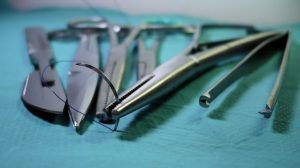Tonsillectomy – Episode 111

What is a Tonsillectomy?
A Tonsillectomy is a surgical procedure to remove the tonsils. Tonsil – immune system tissue in the back of the throat. -Ectomy = to remove something from the body.
Removing the tonsils may be required if chronic tonsilitis is a problem. Chronic tonsilitis is defined as multiple infections in a row or an infection lasting 3 months or longer. Severe snoring and sleep apnea may be another reason to remove the tonsils, for the purpose of opening up the airway.
Adenoids
Adenoids are another set of immune system glands in the back of the nasal cavity. They can also swell during infections and interfere with breathing. Depending on the severity of the infections or the risk of sleep apnea, these may also be removed in the same or a similar procedure.
Tonsillectomy Methods
Since general anesthesia is used in all methods to remove the tonsils, no eating is allowed before the procedure. They also recommend no NSAIDs (non-steroidal anti-inflammatory drugs) are to be used before and after due to their ability to thin the blood and increase the risk of bleeding. In general, a tonsillectomy will take between 30 and 60 minutes. Recovery time afterward is estimated to be about two weeks.
- Scalpel
This is the old school method of using a very sharp surgical knife to cut out the tonsil. This method has the highest risk of bleeding. - Cauterization
This method involves a hot knife that separates the tonsil tissue from the throat. The heat also closes off the blood vessels so bleeding is not as severe. A downside is that the tissue has been burned, so I imagine the pain after this method is more severe. - Ultrasonic Vibration
Ultrasonic waves are sound waves that have a higher frequency than the human ear hears. The waves cause a very rapid vibration and the energy of those waves is what causes the tissue to separate as well as the blood vessels to clot. This is the newest method developed and seems to have the least bleeding and pain.
After the Tonsillectomy
The side effects of a tonsillectomy include swelling of the throat, as well as the face and jaw, bleeding, and infection. To avoid the bleeding and infection, it is important to follow all the instructions given for the recovery period. Because of the swelling, cold foods like ice cream and popsicles are popular because cold things reduce swelling. Popsicles can also help with hydration because swallowing bigger sips or gulps of water can be painful the first few days. Hot foods are not recommended because the heat can increase the pain or reinjure the surgical site. And while ice cream is the most popular post-tonsillectomy food, any soft, non-abrasive foods are fine to eat.
Why do adults have more issues than kids?
Kids heal faster because they are still growing and developing. Kids also have smaller body parts than adults – the tonsils are smaller and the blood vessels are smaller. Smaller blood vessels clot and heal faster than larger ones. This is even true between the different sized blood vessels in your own body. And a factor no one wants to admit: adults are terrible at following directions and truly resting after a surgery or procedure. Rest is the best thing for a healing body of any age or size.
Strep Carriers
Generally, when we think of severe tonsilitis that leads to a tonsillectomy, we think of strep throat. A carrier is someone who carries the germ around with them but does not get sick from the germ (pertussis is another example). In 1998, a study found that 5-15% of school-aged children were asymptomatic carriers of strep. This means they tested positive on a strep swab but had no symptoms of being sick. This causes concern because it means that you can be sick with something else that causes vague symptoms like fever and sore throat but because the strep test is positive, antibiotics are prescribed when they might not be necessary (meaning that you were sick from a virus). This study showed that providers and caregivers were unaware of the number of unnecessary antibiotics they were prescribing.
Strep is eradicated from a carrier by an extensive treatment of antibiotics, or by removing the tonsils from the carrying family member as well as the tonsils of the chronically sick family member. #tonsillectomyforeveryone
Source: https://www.ncbi.nlm.nih.gov/pmc/articles/PMC2851340/
Callback
Facebook Memory: Episode 74
Sleep Hygiene
All About Sleep
Connect with me
Support us on Patreon
Join the Pharmacist Answers Podcast Community on Facebook
Subscribe: iTunes, Stitcher, GooglePlay, TuneIn Radio
Music Credits: Up In My Jam (All Of A Sudden) by – Kubbi https://soundcloud.com/kubbiCreative Commons — Attribution-ShareAlike 3.0 Unported— CC BY-SA 3.0 http://creativecommons.org/licenses/b…Music provided by Audio Library https://youtu.be/tDexBj46oNI
